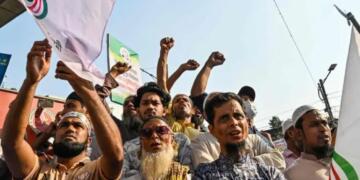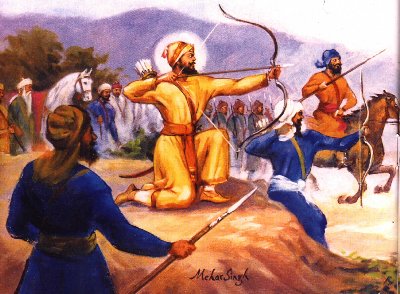On the bitter cold and stormy night of December 5th, 1704 AD, Guru Gobind Singh Ji accompanied by 400 Sikhs left Sri Anandpur Sahib-their home town, owing to the calls of war sounded by Wazir Khan, the Mughal General who had harnessed an army of 10 lakh soldiers to fight 400 Sikhs.
After a prolonged sieze of the town of Anandpur Sahib, Wazir Khan could not dare to attack the Anandgarh Fort. He crooked Guru Sahib to leave Anandpur Sahib, assuring safety to the Guru, his family and his Sikhs by an oath which Aurungzeb and himself took upon the Quran. This oath however, was not meant to be obeyed.
The aim of the Mughal Forces was to present before Aurungzeb the head of Guru Gobind Singh, and they were more than willing to lie on the Quran and their Prophet to achieve that goal.
In the wee hours of 6th December, Guru Gobind sahib and his family accompanied by the Sikhs arrived at the Sirsa river. Here, the Mughal Army attacked them.
Incessant rain, darkness and the cold did not prevent the Guru Sahib ‘s forces in giving the Mughals a memorable fight. Guru Ji, his two elder sons-Baba Ajit Singh and Baba Jhujhar Singh and 40 Sikhs remained after the fight. In the dust and din of the fight, Guru Ji’s two younger son’s- Baba Fateh Singh and Baba Zorawar Singh and Guru Ji’s mother-Mata Gujri were seperated from the rest. It was at Sirsa River that Guru Ji saw his two younger son’s and Mother for the last time.
Guru Gobind Singh and his companions reached Ropar that night and halted. The next day they arrived at Chamkaur Sahib and were provided with the Fort of Chamkaur by the local people. Chamkaur was to witness a bloody battle on 21st and 22nd December that year. A Mughal Army of 10 Lakh were to fight 40 Sikhs. We will discuss the battle after a while. First, the story of the sacrifice of the Guru’s younger sons and Mother needs to be told.
After an arduous journey of the dangerous forest, the ‘chote Sahibzaade'(younger son’s) halted at a Muslim man’s hut for a night. The next morning, Gangu, previously a domestic helper of the Guru’s household approached Mata Gujri and requested her to stay at his house, assuring her all the safety possible. Mata Gujri though reluctant, ultimately yielded to his requests. Upon reaching Gangu’s house, Mata Ji placed her bag and baggage at one corner and the trio went asleep after a tiring journey.
At midnight, Gangu came to their room and stole the gold coins from Mata Ji’s bag. The next morning, he went to the Kotwal of the village and informed him that Guru Gobind Singh’s family members were halted at his house. He was richly rewarded for the information he passed and Mata Gujri and her grandson’ were taken into arrest. They were to be presented before the Nawab of Sirhind for trial. On reaching Sirhind, they were lodged in an extremely cold tower. The young children were to be presented before the Nawab the next day.
Mata Gujri told the children to not fear the cowardly Nawab, and to uphold the Sikh tradition in court. Next morning, the sahibzaade were taken to the Nawab’s Darbar. The entry of the Darbar had been intentionally been reduced to a very small door. To enter the Court, one had to bow. This was done so that the son’s of Guru Gobind Singh would at the very entrance, bow to the Nawab. Two soldiers entered the Darbar by bowing and instructed the children to do the same.
The son’s of Guru Gobind Singh, wittingly, instead of following the soldiers’ method of entering, placed their legs inside the entrance first. As such, they showed the Nawab their feet, which outraged the Darbar. To add to it, the Sahibzaada’s cried aloud, “Waheguru Ji Ka Khalsa, Waheguru Ji Ki Fateh”. Humiliated, the Nawab called the two children serpents, and Guru Gobind Singh an escapee.
The Nawab started preaching to the children that they must convert to Islam in order to save their, and their grandmother’s lives. He offered to them all the wealth and riches and a life of luxury, to which Saahibzaada Fateh Singh, then merely six years of age replied: “Brother dear, our grandfather Guru Teg Bahadur gave his head but stoutly refused to give up his faith. We follow his example. We have received the baptism of the spirit and the two-edged sword. We are the Guru’s lions. Why should we fear death? We are prepared to embrace death rather than to embrace Islam.”
These words were sufficient to inflame the haughty, bigoted Nawab. Although the majority in the Nawab’s court were against the persecution of the innocent children, the Nawab nevertheless ordered that they be bricked alive and then beheaded. On December 27th, 1704, the children of Guru were martyred for this country and its people. Mata Gujri, upon hearing of the cruelty inflicted upon her grandchildren, left for her heavenly abode.
The place where Baba Zorawar Singh and Baba Fateh Singh were bricked, stands a magnificent Gurudwara called Fatehgarh Sahib. Here at Chamkaur, on 22nd December, the Mughal Forces tried to capture the Anandgarh Fort. Every time they tried to do so, the 40 Sikhs showered arrows on them. Impatient and humiliated that a force as strong as theirs could not capture a fort guarded by 40 men, the Mughal Forces came ahead to break into the entrance of the fort. The Sikhs gave them a strong resistance and killed many Mughals in the effort.
The ammunition of the Khalsa force was now over. However brave one may be, 40 men cannot defeat an army of lakhs. Guru Gobind Singh here commanded: “Sawa Lakh Se Ek Ladaun, Tabhe Gobind Singh Naam Kahau” which translates to “Call me Gobind Singh, only, when each of my Sikh will fight with more than one and a quarter lakh of the enemy.” And so it was. The Sikhs grouped themselves into a jatha(group) of five men each and went into the battlefield one group at a time. These jathas caused unprecedented and unexpected casualties to the Mughal forces.
Baba Ajit Singh took Guruji’s blessings and went into the battlefield. He fought till the last breath. Next, Baba Jhujhar Singh too went into the battlefield, leading his jatha. He too, met with the same fate. Sensing the danger to Guru’s life, the ‘Panj Pyaare’, the beloved five(of whom only two remained) pleaded to the Guru to leave the fort and save himself. They elucidated that the Khalsa is yet to shake the roots of the Mughal Empire and that if Guru Gobind Singh doesn’t survive, that goal would not be achieved. The Guru rejected these requests.
The two Pyaaras now reminded the Guruji that he had bestowed upon them the authority to take decisions for the welfare of the Khalsa Panth. As such, they commanded Guru Gobind Singh to leave the fort and save his life, and that of the Khalsa panth. The Guru, now duty bound, decided to leave the fort in the darkness of the night.
At night, when Guruji along with three of his men was leaving the fort, he stumbled upon the martyred bodies of his two sons. One of the Sikh went over to cover their bodies with a cloth, but the Guru immediately restrained him from doing so. Upon inquiring as to why he didn’t allow the same, Guru Sahib replied, “All those who are lying martyred here are my sons. If you have enough cloth to cover all my sons, you may proceed, and if you don’t, then none of them shall be covered.” Such was the greatness of the Guru.
Guru Gobind Singh then wrote a letter to Aurungzeb entitled ‘Zafarnama’. Below are quoted a few lines of the same:
“I have no faith whatsoever in your oaths to which you took God as witness. I do not have a particle of confidence in you. What happened at Chamkaur is that forty men reduced to hunger could do nothing when lakhs fell on them, suddenly and unawares. The oath breakers attacked them abruptly with swords, arrows and muskets. At last, many were killed on both sides and the earth was covered with blood. Corpses lay in heaps-The brave Sikh warriors fought most valiantly, not caring for their lives. But how could forty, even braver than the bravest, succeed against a countless host? O faithless man, you are given to swearing false oaths, which you never keep. You keep no faith and observe no religion. You have no idea of what an oath on the Quran means, nor do you have any faith in God. Were you to take a hundred oaths on the Quran, I would not trust you even in the slightest.”
Upon receiving the letter of Guru Gobind Singh, Aurangzeb, who at the time was in Ahmadnagar in the Deccan was filled with repentance.
It deepened his remorse for the past and his fear and anxiety about the future. The emperor called upon the Guru to meet him so that he could beg for pardon. The Guru acknowledged his invitation and set out for Ahmadnagar. However, Aurangzeb died on 20th February, 1707. He did not have the fortune of seeing the Guru.
Guru Gobind Singh, who himself knew he did not have many days to dwell in this world, appointed Banda Singh Bahadur as the commander of the Khalsa force. Banda Singh Bahadur achieved great success in crushing the Mughal Empire in the North. The Khalsa Forces, under his leadership, captured Delhi and the Sikh Empire began to substitute the Mughal era. Guru Gobind Singh also abolished the practice of humanly ‘Gurus’ and anointed Guru Granth Sahib as the immortal Guru of the Sikhs.
He quoted: ” The system of personal Gurus ends with me. The Khalsa Panth will guide itself by the teachings of the Guru as incorporated in Guru Granth Sahib.” Then the Guru lay down and returned to the Eternal Home on 7th October, 1708. He was less than 42 years of age.
A poem of Baba Bulle Shah glorifies the existence of Guru Gobind Singh. It reads:
“Na Baat Kahu Ab Ki, Na Baat Kahu Tabki
Agar Na Hote Guru Gobind Singh toh Sunnat Hoti Sabki.”































